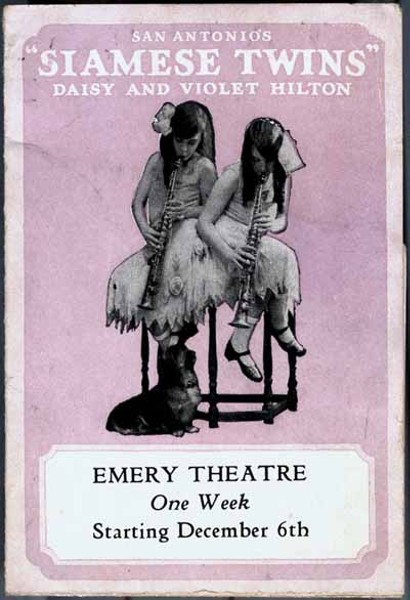Even though "celebutante" Paris Hilton has apparently turned her sometimes-sordid life around, she still dominates the tabloids with her comings and goings. It's odd that Americans are so obsessed with an attractive, rich, and otherwise normal girl, and, to a lesser extent, her more reclusive sister, Nicky. Maybe it's because the Hilton sisters live in what many perceive to be an exotic world, inaccessible to us common folk. But often when we look westward for exotic escapes, we overlook the fantastic that happens in our own backyards.
For instance, few people recall that before Paris and Nicky Hilton came to dominate the pop culture compost heap, there were two other Hilton sisters, equally as exploited by the tabloid rags of their day: Daisy and Violet Hilton. They spent the last six years of their life in Charlotte, and it was a single life they possessed -- because they were what is colloquially known as Siamese twins.
Of course, on the surface that doesn't seem so strange at all. Perhaps Charlotte makes sense as a place where conjoined twins might come to live in peace. After all, despite our geographical aesthetic for the grossly curious (watching dozens of cars travel in a circle for hours in the middle of a gas crunch is a bit strange, you must admit) Southerners are by and large polite, private people.
But the Hilton sisters didn't make a decision to live in Charlotte; that decision was made for them. And even a cursory examination of their existence reveals a life at the mercy of fate and unscrupulous people looking to profit from the exploitation of human beings.
It is an odd twist of fortune that the Hilton twins, who chased fame and riches throughout nearly all of their shared 60 years, should end up penniless in Bank Town, working in a grocery store.
Of course, as with any story full of so many turns, the truth of the ending resonates only when we know the events preceding it. Dean Jensen has written an entertaining and well-researched biography, The Lives and Loves of Daisy and Violet Hilton: A True Story of Conjoined Twins, which clocks in at more than 400 pages. I would recommend that anyone desiring a detailed accounting of the Hilton sisters delve into that. The Charlotte-based Queen City Theatre Company will also present a production of Side Show -- a play that chronicles the adventures of the Hilton sisters -- from July 3-26 at McGlohan Theatre; but, in brief, their lives went something like this:
The twins were born out of wedlock to Kate Skinner in February 1908 in Brighton, England. As Jensen reports in his book, Kate Skinner was a basket case after the birth of her daughters. Her pregnancy had been difficult, and while a normal delivery is painful enough, one cannot begin to imagine giving birth to babies that must be brought into the world simultaneously. (It is worth noting, I think, that Kate Skinner was a twin herself, as was her father.) The twins were what is known medically as pygopagus twins -- they were connected at the pelvis (Daisy on the right; Violet on the left) by a tuberous portion of flesh; they shared blood circulation but no organs. The arrangement of their connection made it so that later in life they moved, more or less, with ease, in a type of "V" formation.
Also, as this was 1908 in England, sharp on the heels of Victorianism, Skinner thought that the condition of her twins was a punishment for adultery. She wanted nothing to do with them. And when it became clear two weeks after their birth that Daisy and Violet were going to survive, Mary Hilton, a woman who held the dual post of landlady and midwife to Skinner, adopted them.
Of course, to say that the conjoined twins were adopted is somewhat of a misnomer. They were essentially slaves. I say that because Mary Hilton began "exhibiting" the girls in saloons by the time they were a year old, profiting from their condition, and upon her death, Hilton willed the girls to her daughter, Edith, and her husband Myer Myers. One bequeaths property, not people, and people passed on as such are slaves, plain and simple.
The poor treatment at the hands of Mary Hilton, and later the Myers, was as bad as you might expect. And when you consider that the twins were "in the care" of their handlers until the age of 21, you realize that there was most likely little difference between the torment of their public lives of spectacle and their private existence of indentured servitude.
But Daisy and Violet Hilton, once emancipated from the Myers in a court case in Texas that netted the twins $80,000, sought out an even more public life. Like our modern day Hiltons, it seems as though once they had a taste of tabloid attention, it was impossible to imagine a life of normalcy. Then again, nothing about their life had been normal from the beginning.


